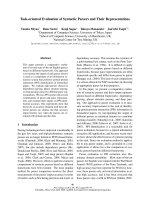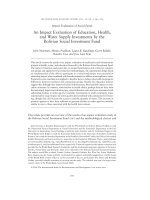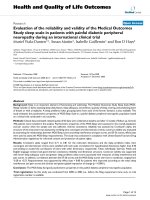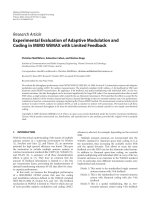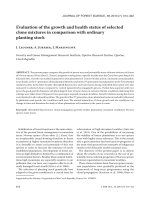Evaluation of manning’s coefficient of ferrocement trapezoidal and semicircle canals strengthened by CFRP sheets
Bạn đang xem bản rút gọn của tài liệu. Xem và tải ngay bản đầy đủ của tài liệu tại đây (1.63 MB, 10 trang )
INTERNATIONAL JOURNAL OF
ENERGY AND ENVIRONMENT
Volume 6, Issue 5, 2015 pp.461-470
Journal homepage: www.IJEE.IEEFoundation.org
ISSN 2076-2895 (Print), ISSN 2076-2909 (Online) ©2015 International Energy & Environment Foundation. All rights reserved.
Evaluation of manning’s coefficient of ferrocement
trapezoidal and semicircle canals strengthened by CFRP
sheets
Hayder T. Nimnim, Batool A. Farhan
Department of Civil Engineering, Faculty of Engineering, University of Kufa, Najaf, Iraq.
Abstract
This study investigates the hydraulic principle of ferrocement canals strengthened by CFRP sheets, and
evaluates the effect of CFRP sheets on the hydraulic principle of the flow, especially on Manning
roughness coefficient with different shape of canal section, discharges and slopes. The present study is
conducted by using twelve specimens of ferrocement open canals, six of these have trapezoidal shape
and residual specimens have semicircle shape. Trapezoidal canals have the same cross-section, 39.23cm
bottom width, 35cm depth, 60˚ side slope, 2.5cm thickness and the length is 160cm for ferrocement
trapezoidal canal depending on the best hydraulic section for trapezoidal canal. And for semicircle canal,
70 cm diameter. All canals were 2.5cm thickness and have length 160cm. In the first part of experimental
work, every group of canals is linked together to be two flumes with length (9.6m) to find the Manning
roughness coefficient for trapezoidal and semicircle ferrocement canals. Three different cases of linked
canals are investigated (without CFRP, with 5 strips of CFRP and with 15 strips of CFRP). Each case has
three slopes (1/480, 1/320 and 1/240) and each slope conducted five discharges (2, 4, 6, 8 and 10) l/sec.
From experimental data for ferrocement trapezoidal canal, it was found that at slopes of (1/480, 1/320
and 1/240) the Manning roughness coefficient (n) is decreased by about (4.6%, 4.5% and 5%)
respectively in second case, and it is decreased about (15.3%, 15.14% and 14.56%) respectively in third
case at the maximum discharge. And from experimental data for ferrocement semicircle canal, it was
found that at slopes of (1/480, 1/320 and 1/240) the Manning roughness coefficient (n) is decreased by
about (5.2%, 4.7% and 5.04%) respectively in second case, and it is decreased about (16.23%, 16.76%
and 16.27%) respectively in third case at the maximum discharge.
Copyright © 2015 International Energy and Environment Foundation - All rights reserved.
Keywords: ferrocement; CFRP sheets; Manning coefficient; Open canals.
1. Introduction
Ferrocement construction technology is quite popular throughout the world. It is a thin element of
concrete used as a building construction as well as a repair material [1]. There are many structures built
of ferrocement such as housing units, shell roofs, water tanks, swimming pools, biogas digesters, silos,
food storage units and for some specialized applications such as floating marine structures for which
reinforced concrete is too heavy, ferrocement is a preferred choice over reinforced concrete [2-4].
Ferrocement is constituted of wire mesh reinforcement impregnated with mortar to produce elements of
small thickness, high durability and resilience and, when properly shaped, high strength and rigidity [5].
International Journal of Energy and Environment (IJEE), Volume 6, Issue 5, 2015, pp.461-470
ISSN 2076-2895 (Print), ISSN 2076-2909 (Online) ©2015 International Energy & Environment Foundation. All rights reserved.
462
2. Scope of work and construction of ferrocement canals
The experiments have been conducted laboratory at Kufa University, Najaf, Iraq. Laboratory work
consists of casting 12 model of ferrocement canals, six of which have trapezoidal section and the other
six have a semi-circular section. The dimensions of trapezoidal canals was 39.23cm bottom width, 35cm
depth, 60˚ side slope, 2.5cm thickness and the length is 160 cm depending on the best hydraulic section
for trapezoidal canal. For semicircle canal, 70cm diameter, 2.5cm thickness and have length 160cm.
Each set of these models has the same shape connected together by epoxy material on metal base to
create trapezoidal canal and semicircular canal, each canal having a length of 9.6m. Both canals were
made from the same material and the same method of work (different in section shape only). Reinforcing
steel for each specimen of canals is in form of three layers of wire mesh, the first layer placed is a wire
mesh, followed by four longitudinal reinforcement with diameter 4mm. The second layer is from wire
mesh, then transverse reinforcement with 4mm @ 40cm c/c for each cross section is placed, followed by
a third layer of wire mesh, and the steel template for trapezoidal canal as shown in Figures 1 and 2 for
semicircular canal.
Figure 1. Canal dimensions and steel mold for trapezoidal canal
Figure 2. Canal dimensions and steel mold for semicircle canal
International Journal of Energy and Environment (IJEE), Volume 6, Issue 5, 2015, pp.461-470
ISSN 2076-2895 (Print), ISSN 2076-2909 (Online) ©2015 International Energy & Environment Foundation. All rights reserved.
463
All materials used in this study were conformed to Iraq specification. In the present study, the mix
proportion of cement mortar used in casting canals specimen was 1:2 ratio by weight (cement : sand)
with a water/cement ratio of 0.45.
The formwork for trapezoidal canal was constructed from plywood according to the dimensions of the
model. In addition, the plywood was chosen due to its water resistant qualities and also the smooth
surface for casting. And the formwork for semicircle canal was constructed from steel according to the
dimensions of the model. Prior to the ferrocement pouring the entire formwork was generously coated
with oil to prevent the ferrocement bonding to the formwork. This made the removal of the specimen
much easier. It was important that after each casting the formwork was thoroughly cleaned to ensure
there were no imperfections in the next specimen.
In order to find the Manning’s roughness coefficient (n) of ferrocement canals without strengthened and
ferrocement canals strengthened by CFRP sheets for ferrocement trapezoidal and semicircular sections,
this study employs systematically to install of (6) separate trapezoidal part canals, each (1.6m) long,
(39.23cm) width in bottom, (35cm) depth, giving a total length of (9.6m), and install of (6) separate
semicircle part canals, each (1.6m) long, (70cm) diameter, (35cm) depth, giving a total length of (9.6m)
respectively. Each group of similar canal raised and put it on a steel base.
Then, canals were supported and linked at the joints by (epoxy material). After that, the model fixed
straight and horizontal after it was given a zero slope via level device. And water is supplied to canal by
recirculation system of water supply for two canals (trapezoidal and semicircle canal) as shown in Figure
3. Pump capacity of (10 l/sec) is used to pumping water from reservoir tanks to the canal equipped with
(3inch) diameter pipes. Fallowing water entry to canal, it collides with screen is located at (30cm) from
upstream of the canal, this leads to reduction of water turbulence. At the end of the experimental canal,
water is allowed to flow through a V-notch weir, V- notch weir is located at (70cm) from downstream, it
works to measure the discharge and compare the results with volumetric method, this help for
calibration. Then is followed by collecting water by tank, then the water is pumped back, thus setting is
completed when water returns to reservoir tank again.
Figure 3. Sectional drawing of experimental canal (all dimensions in cm)
This system applies for trapezoidal and semicircle canals for three cases:
1. Ferrocement canals without CFRP (Figures 4, 5).
2. Ferrocement canals strengthened by five strips of CFRP sheets with 5 cm width and (120cm) long
for trapezoidal canal and (110cm) long for semicircle canal with transverse direction (Figures 6, 7).
3. Ferrocement canals strengthened by fifteen strips of CFRP sheets with (5cm) width and (120cm)
long for trapezoidal canal and (110cm) long for semicircle canal with transverse direction (Figures 8,
9).
Each case is conducted in the experiment using three slope, (1/480, 1/320 and 1/240). In addition, used
five discharges (2, 4, 6, 8 and 10) l/sec for each slope case. From each experiment, calculated average
depth of water and entered in Manning equation to find Manning roughness coefficient for each case.
International Journal of Energy and Environment (IJEE), Volume 6, Issue 5, 2015, pp.461-470
ISSN 2076-2895 (Print), ISSN 2076-2909 (Online) ©2015 International Energy & Environment Foundation. All rights reserved.
464
Figure 4. Trapezoidal canal without CFRP sheet
Figure 5. Semicircle canal without CFRP sheets
Figure 6. Trapezoidal canal with 5 CFRP sheets
Figure 7. Semicircle canal with 5 strip of CFRP
International Journal of Energy and Environment (IJEE), Volume 6, Issue 5, 2015, pp.461-470
ISSN 2076-2895 (Print), ISSN 2076-2909 (Online) ©2015 International Energy & Environment Foundation. All rights reserved.
465
Figure 8. Trapezoidal canal with 15 CFRP sheet
Figure 9. Semicircle canal with 15 strip of CFRP
3. Results of manning roughness coefficients for ferrocement trapezoidal canal
The Manning’s roughness coefficient is the most important parameter for proper estimation of discharge
in an open canal flow. Manning formula has been widely used to determine the roughness coefficient.
The variation of roughness coefficient occurs due to the many contributing factors, surface roughness,
vegetation, channel irregularity, channel alignment, silting and scouring, shape and size of a channel,
obstruction and discharge. The determination of (n) has become a challenge because the values cannot be
computed equally for all types of open channels. The influence of bed roughness gives some effect to
flow rate and also the roughness characteristics. Assuming the flow to be uniform and the energy
gradient slop can be considered equal to the average longitudinal bed slop of a channel. Under steady and
uniform flow conditions, the use of equations proposed by Manning formula (1891) to compute the
Manning roughness coefficient proposed as Manning’s [2, 6].
n=
1
Q
R
2
3
S
1
2
A (1)
A=b*yavg*z*yavg2 (2)
P=b+2*yavg*1 + z
2
(3)
R=A/P (4)
Where, b=39.23cm, and z=1/
3 {for the present dimension of the trapezoid section, Q=the discharges
(l/sec), n = Manning roughness coefficient, dimensionless, yavg= the depth of flow (cm), R = the
hydraulic mean radius of the canal section (cm), P= wetted parameter of the canal section (m), S = the
bed slope of canal, dimensionless, A = the canal cross-sectional area (m
2
), b= width of the canal (m) and
z= side slope of the canal, dimensionless.
Figures 10, 11 and 12 explains the laboratory results for Manning roughness coefficient with discharges
for slopes (1/480), (1/320) and (1/240) respectively with different cases by using CFRP (without CFRP
sheets, five strips and fifteen strips). For all cases, it may be seen the Manning roughness coefficient
decreases with increasing the ratio of CFRP in the ferrocement trapezoidal canal.
International Journal of Energy and Environment (IJEE), Volume 6, Issue 5, 2015, pp.461-470
ISSN 2076-2895 (Print), ISSN 2076-2909 (Online) ©2015 International Energy & Environment Foundation. All rights reserved.
466
Figure 10. Manning roughness coefficient vs. discharge for trapezoidal canal for slop=0.002083
Figure 11. Manning roughness coefficient vs. discharge for trapezoidal canal for slop =0.003125
0.01
0.011
0.012
0.013
0.014
0.015
0.016
0 1 2 3 4 5 6 7 8 9 10 11
Manning roughness coefficient (n)
Discharge in l/sec
without CFRP
sheets
with 5 strips of
CFRP sheets
with 15 strips of
CFRP sheets
0.01
0.011
0.012
0.013
0.014
0.015
0.016
0 1 2 3 4 5 6 7 8 9 10 11
اManning roughness coefficient
اDischarge in l/sec
without CFRP sheets
with 5 strips of CFRP
sheets
with 15 strips of CFRP
sheets
International Journal of Energy and Environment (IJEE), Volume 6, Issue 5, 2015, pp.461-470
ISSN 2076-2895 (Print), ISSN 2076-2909 (Online) ©2015 International Energy & Environment Foundation. All rights reserved.
467
Figure 12. Manning roughness coefficient vs. discharge for trapezoidal canal slop =0.004167
4. Results of manning roughness coefficients for semicircular section
A canal roughness can be described through Manning roughness coefficient n as stated at the following
equation
Chow, 1959
.
n=
1
Q
R
2/3
xS
1/2
A (5)
A=1/8( sin ) do2 (6)
P=1/2**do (7)
=2*cos
1
(1
2yave
d
o
) (8)
R=1/4(1-
sin
)*do (9)
Where, Q= The discharge in l/sec, n= The Manning roughness coefficient, yavg= The average depth of
flow for four reading in canal (cm), do= Diameter of semicircle section (70 cm), S= The bed slop of
canal, A= Cross sectional area of flow(m2), R = Hydraulic radius (m) and = Angle of water surface.
The experimental work for semicircular canal was the same procedure for the trapezoidal canal. The
work was also in three cases for using CFRP sheets (without using CFRP, with five strips and with
fifteen strips) with three values for the slope (1/480, 1/320 and 1/240) and each slope conducted five
discharges (2, 4, 6, 8 and 10) l/sec to find Manning roughness coefficient of semicircular ferrocement.
The Figures 13, 14 and 15 explains the laboratory results for Manning roughness coefficient with
discharges for slopes (1/480), (1/320) and (1/240) respectively with different cases by using CFRP
(without CFRP sheets, five strips and fifteen strips). For all cases, it may be seen the Manning roughness
coefficient decreases with increasing the ratio of CFRP in the ferrocement semicircle canal.
0.01
0.011
0.012
0.013
0.014
0.015
0.016
0 1 2 3 4 5 6 7 8 9 10 11
Manning roughness coefficient
Dischargein l/sec
without CFRP sheets
with 5 strips of CFRP
sheets
with 15 strips of
CFRP sheets
International Journal of Energy and Environment (IJEE), Volume 6, Issue 5, 2015, pp.461-470
ISSN 2076-2895 (Print), ISSN 2076-2909 (Online) ©2015 International Energy & Environment Foundation. All rights reserved.
468
Figure 13. Manning coefficient vs. discharge for semicircle canal for slop=0.002083
Figure 14. Manning coefficient vs. discharge for semicircle canal for slop=0.003125
0.01
0.011
0.012
0.013
0.014
0.015
0.016
0 1 2 3 4 5 6 7 8 9 10 11
manning roughness coefficent
discharge in l/sec
without CFRP
sheets
with 5 strips
of CFRP sheets
with 15 strips
of CFRP sheets
0.01
0.011
0.012
0.013
0.014
0.015
0.016
0 1 2 3 4 5 6 7 8 9 10 11
manning roughness coefficent
discharge in l/sec
without CFRP
sheets
with 5 strips of
CFRP sheets
with 15 strips of
CFRP sheets
International Journal of Energy and Environment (IJEE), Volume 6, Issue 5, 2015, pp.461-470
ISSN 2076-2895 (Print), ISSN 2076-2909 (Online) ©2015 International Energy & Environment Foundation. All rights reserved.
469
Figure 15. Manning coefficient vs. discharge for semicircle canal for slop=0.004167
5. Conclusion
From the experimental work results for ferrocement trapezoidal and semicircular canals with and without
CFRP sheets, the following main conclusions are obtained;
1) Manning roughness coefficient (n) is decreased with the increasing ratio of CFRP sheets to
ferocement. In the slopes (1/480, 1/320 and 1/240) by follow;
For trapezoidal ferrocement canal;
(a) At slope (1/480), Manning's roughness coefficient decreases with the increasing of the proportion of
CFRP in canal. For discharges (2, 4, 6, 8 and 10) l/sec, Manning roughness coefficient decreases by
about (5.9%, 5.97%, 5.7%, 5.2% and 4.6% ) respectively when the CFRP sheets are (5) strips in
canal while this reduction increased to (18%, 17%, 16.7%, 16% and 15.3%) respectively when the
CFRP sheets are (15) strips in canal.
(b) At slope (1/320), Manning roughness coefficient decreases with the increasing of the ratio of CFRP
in ferrocement trapezoidal canal, for discharges (2, 4, 6, 8 and 10) l/sec, Manning roughness
coefficient is reduced by about (5.8%, 5.6%, 5.5%, 5.1% and 4.5%) respectively when the CFRP
sheets are (5) strips in canal while this reduction is increased to (17.1%, 16.4%, 15.6%, 15.25% and
15.14%) respectively when the CFRP sheets are (15) strips in the trapezoidal ferrocement canal.
(c) At slope (1/240), Manning roughness coefficient decreases with the increasing of the ratio of CFRP
in the ferrocement trapezoidal canal. For discharges (2, 4, 6, 8 and 10) l/sec, Manning roughness
coefficient is reduced by about (5.34%, 5.4%, 5.44%, 5.56% and 5%) respectively when the CFRP
sheets are five stripe in the canal while this reduction is increased to (17.63%, 16%, 14.5%, 15% and
14.56%) respectively when the CFRP sheets are fifteen strips in the trapezoidal ferrocement canal.
For semicircle ferrocement canal;
(a) At slope (1/480), Manning's roughness coefficient decreases with the increasing of the proportion of
CFRP in the canal. For discharges (2, 4, 6, 8 and 10) l/sec, Manning roughness coefficient decreases
by about (5.7%, 5.5%, 5.38%, 5.4% and 5.2%) respectively when the CFRP sheets are (5) strips in
the canal while this reduction is increased to (18.1%, 17.55%, 16.7%, 16.88% and 16.23%)
respectively when the CFRP sheets are (15) strips in canal.
0.01
0.011
0.012
0.013
0.014
0.015
0.016
0 1 2 3 4 5 6 7 8 9 10 11
manning roughnss coefficient
discharge in l/sec
without CFRP
sheets
with 5 strips of
CFRP sheets
with 15 strips of
CFRP sheets
International Journal of Energy and Environment (IJEE), Volume 6, Issue 5, 2015, pp.461-470
ISSN 2076-2895 (Print), ISSN 2076-2909 (Online) ©2015 International Energy & Environment Foundation. All rights reserved.
470
(b) At slope (1/320), Manning roughness coefficient decreases with the increasing of the ratio of CFRP
in the canal. For discharges (2, 4, 6, 8 and 10) l/sec, Manning roughness coefficient is reduced by
about (5.62%, 5.5%, 5.49%, 5.2% and 4.7%) respectively when the CFRP sheets are (5) strips in the
canal while this reduction is increased to (16.35%, 17.3%, 16.7%, 16.8% and 16.76) respectively
when the CFRP sheets are (15) strips in the semicircular ferrocement canal.
(c) At slope (1/240), Manning roughness coefficient decreases with the increasing of the ratio of CFRP
in canal. For discharges (2, 4, 6, 8 and 10) l/sec, Manning roughness coefficient is reduced by about
(5.33%, 5.4%, 5.43%, 5.56% and 5.04%) respectively when the CFRP sheets are five strips in the
canal while this reduction is increased to (16.8%, 17.1%, 16.2%, 16.88%, and 16.27%) respectively
when the CFRP sheets are fifteen strips in the semicircular ferrocement canal.
From laboratory results, it may be seen that; Manning roughness coefficient changed with the change of
the canal section shape with stability of all other factors, from this can be observed, Manning roughness
coefficient for semicircular canal is less than Manning roughness coefficient for trapezoidal canal.
References
[1] Abasolo R., Bandivas C., Guinita J., Palen J., Parners E. and Apor G. (2009). “Utilization of
Ferrocement as Flexural Building Member” Xiraadman Research Center, Xavier University,
Philippines. .
[2] Chow, V.T., (1959). “Open Channel Hydraulics”: New York, McGraw-Hill, p. (98-115).
[3] Hago A.W., Al-Jabri K.S., Alnuaimi A.S., Al-Moqbali H. and Al-Kubaisy M.A., (2005),
“Ultimate and Service Behaviour of Ferrocement Roof Slab Panels”, Construction and Building
Materials, No19, pp. (31-37).
[4] Naaman Antoine E., (2000). “Ferrocement& Laminated Cementitious Composites” Michigan,
USA. ASCE, ISBN, 0-9674939-0-0.
[5] Sakthivel P.B., (2011). “ Ferrocement Construction Technology and its Applications – A Review”,
Jerusalem College of Engineering, Chennai, India.
[6] Zarina Ali and Nor AshikinSaib, (2011). “Influence of bed Roughness in Open Channel”
Departement of Water and Environmental Engineering, Tun Hussein university, Malaysia.


